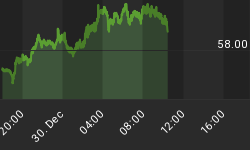How much risk are you exposed to? Below is a chart of the DOW ($INDU) divided by the NASDAQ ($COMPQ). Markets bottom when this ratio hits peaks and they tend to top out when the ratio hits troughs. It's an inverse relationship between the ratio and stock market indexes.

This chart reflects the ratio spends most of the time between 4.5 to 6.0. When the ratio hits or exceeds these levels it represents excessive fear or greed in the market place.
When stocks trend higher, market participants reach for more return by taking on more risk buying NASDAQ components. This increase demand for riskier stocks drives the ratio lower, as NASDAQ stocks out perform blue chips.
Conversely, during market sell offs, investors sell stocks with the most associated risk (NASDAQ components), which drives the ratio higher, as NASDAQ stocks under perform blue chips
Stock Market Bottoms: Since most market bottoms have tended to V-bottom in price in the past, this ratio tends to spike into peaks, which provides a little better timing guide than stock market tops.
Stock Market Tops: You'll notice the ratio can stay around or below 4.5 for a while when a market is bullish or making a top. It doesn't work as timely as it does with market bottoms, but merely indicates risk or greed levels are elevated.
SUMMARY: This ratio is not a primary or secondary tool for me in technical analysis, but more of a general over all gauge of market fear or greed. The markets have been on a strong move higher for the past year, and market participants have stretched for return and higher risk stocks have out performed the blue chips. The ratio is currently at the 4.5 level, which indicates market risk is at elevated levels.
In addition, the one group who probably understands the economy going forward better than anyone are corporate executives. They've been selling stock holdings of their employers at record paces over the past several months. That's not exactly a screaming endorsement.
Lastly, mutual fund cash levels are historically at extremely tight (low) levels. It's their cash that tends to drive buying power and sentiment, and if their cash levels are depleted where is the future buying demand in bulk going to come from?
While market prices can continue to grind higher in the near term, it seems like very important gauges are telling us, "That adding to the long side of the market (chasing returns) might very well be foolish". I've discussed in several recent blogs that I expect some kind of market top by the end of March or During April, and I still see that to be the case for the time being. If you're making your investment decisions based on risk first making money second, now doesn't seem like the time to deploy new capital. Conversely, it seems like protective strategies are smarter for the prudent minded investor.
Hope all is well.















